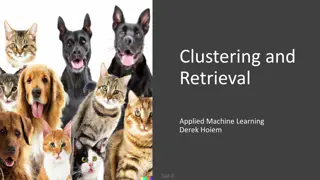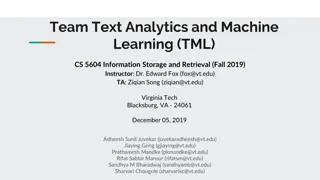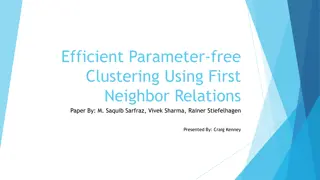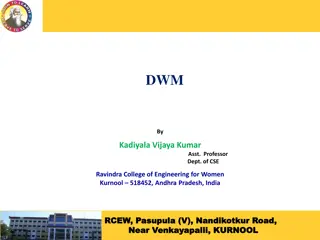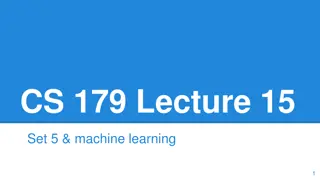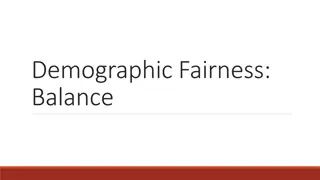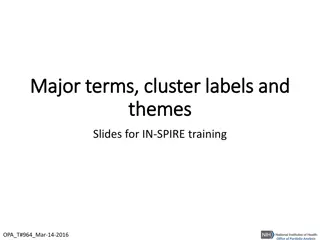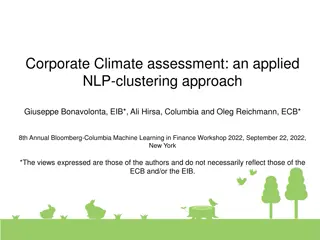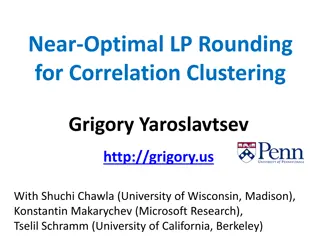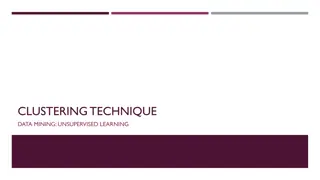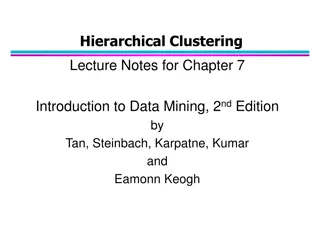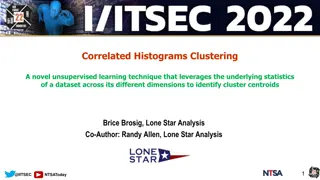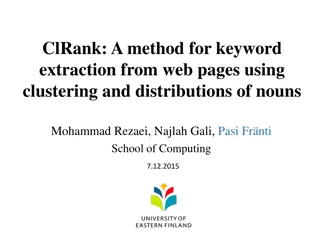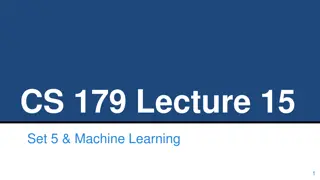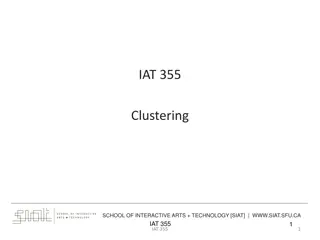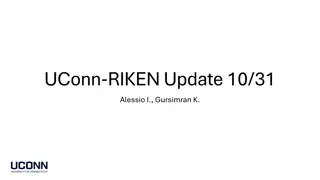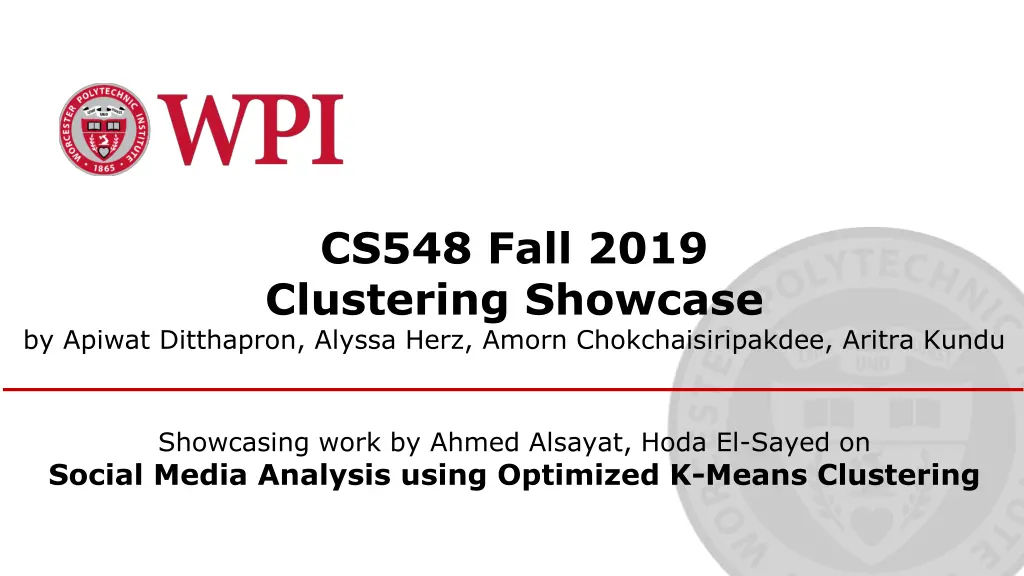
Optimized K-Means Clustering for Social Media Analysis
Explore a research paper showcasing the application of optimized K-Means clustering on social media data for valuable insights in various domains like business, bioscience, health trends, disease spread, and more. The study focuses on maximizing inter-cluster distance to group similar individuals, using a dataset from Slashdot forum preprocessed with Knime tool.
Download Presentation

Please find below an Image/Link to download the presentation.
The content on the website is provided AS IS for your information and personal use only. It may not be sold, licensed, or shared on other websites without obtaining consent from the author. If you encounter any issues during the download, it is possible that the publisher has removed the file from their server.
You are allowed to download the files provided on this website for personal or commercial use, subject to the condition that they are used lawfully. All files are the property of their respective owners.
The content on the website is provided AS IS for your information and personal use only. It may not be sold, licensed, or shared on other websites without obtaining consent from the author.
E N D
Presentation Transcript
CS548 Fall 2019 Clustering Showcase by Apiwat Ditthapron, Alyssa Herz, Amorn Chokchaisiripakdee, Aritra Kundu Showcasing work by Ahmed Alsayat, Hoda El-Sayed on Social Media Analysis using Optimized K-Means Clustering
References [1] A. Alsayat and H. El-Sayed, "Social media analysis using optimized K- Means clustering," 2016 IEEE 14th International Conference on Software Engineering Research, Management and Applications (SERA), Towson, MD, 2016, pp. 61-66. doi: 10.1109/SERA.2016.7516129 [2] Ujjwal Maulik and Sanghamitra Bandyopadhyay. Genetic algorithm based clustering technique. Pattern recognition, 33(9):1455 1465, 2000. [3] V. G mez, A. Kaltenbrunner, and V. L pez, Statistical analysis of the social network and discussion threads in slashdot, Proceeding of the 17th international conference on World Wide Web - WWW 08, Apr. 2008.
Motivation and Background Social Media has proven increasingly valuable for finding groups of individuals in the following areas Business Marketing/Advertising Bioscience Tracking health trends Spreading of disease Social Science Support for political candidates The rate of digital interaction through popular social networking sites is at an all time high, however this makes data mining harder because of the large datasets present today Taken from trzcacak.rs Worcester Polytechnic Institute 3
Motivation and Background The goal of this research paper is two folds: overcome a major drawback of the K-means algorithm i.e. initial clusters maximize inter cluster distance between clusters of data points The authors try to put similar people into the same category or cluster. Once a dataset has been clustered, it can identify group behavior of an individual which provides valuable insights as has been show in a use case. Worcester Polytechnic Institute 4
Dataset and data preprocessing Dataset was obtained from Slashdot forum which has 24000 users 140,000 comments 496 articles on politics Taken From coralproject.net/blog/ The Slashdot dataset can be used for text mining, network analysis and data mining to understand sentiment analysis which allows members of a community to rate other users based on the individual response to news. Each user has authority score (leadership behaviour, between 0 and 1) hub score (follower behaviour, between 0 and 1) rating(positive or negative, between -1 and 5) [3] Taken From www.dataversity.net/contributors /rosaria-silipo/knime-logo/ Authority score and hub score are obtained using sentiment analysis from a bag of words of all published posts [3]. Dataset provided by Barcelona Media, which was pre-processed using the Knime tool. Worcester Polytechnic Institute 5
Slashdot networking diagrams on NASA topic Each dot represents a user The larger the dot the more active Each line connects interactions between users Worcester Polytechnic Institute 6
Methods Genetic Algorithm (GA) K-Means Clustering Optimized Cluster Distance (OCD) re-clustering of data with new centers increasing the between cluster distances (BSS) decreasing within cluster distances (WSS) Worcester Polytechnic Institute 7
Genetic Algorithm Evolutionary Algorithms (EA) Promote problem solving -> optimizing techniques Population -> Generational Group Creating the next generation Taken from https://apacheignite.readme.i o/docs/genetic-algorithms. Worcester Polytechnic Institute 8
K-Means Clustering Unsupervised clustering algorithm to find groups within the data To partition the n observations into a set of k clusters To minimize the within-cluster sum of squares (WSS) -> SSE : number of center/cluster : set of observation in cluster i : centroid in : observation Worcester Polytechnic Institute 9
Proposed Algorithm (K-means + GA + OCD) Genetic Algorithm(GA) Instead of randomly selecting k points as centroids, an optimal set of centroid is generated by GA as example: Input data Initial Population Taken from [1] Worcester Polytechnic Institute 10 Taken from [2]
Proposed Algorithm (K-means + GA + OCD) Genetic Algorithm(GA) 1st Generation (51.6,72.3,46.5), (18.3,15.7,23.2), (29.1,32.2) Crossover (51.6,15.7,23.2), (18.3,72.3,46.5), (29.1,32.2) Mutation (low chance) (32.2,15.7,23.2), (18.3,72.3,46.5), (29.1,51.6) Fitness of 1st Generation is calculated by The centroids of generation with the highest fitness is returned as an output of the GA Taken from [1] Worcester Polytechnic Institute
Proposed Algorithm (K-means + GA + OCD) Optimized Cluster Distance Euclidean distances between all centroid are calculated called pairwise distances. For two clusters that have the pairwise distance higher than the average of all pairwise distances, GA and K-means are re-applied on those two clusters to maximize between cluster distance. Worcester Polytechnic Institute 12 Taken from [1]
Results: Visualization of Clusters Component 1 & 2 created from PCA to show data in 2 dimensions with clustering result Worcester Polytechnic Institute 13 Taken from [1]
Results: Group Characteristics Reason behind rankings was not given. Assuming based on thresholds based on distribution of scores Attitude Activity Levels: Rating given by other users Rankings Positive Negative Neutral Actually neural Mix of positive and negative Combination of hub and authority scores Rankings High Moderate Low Worcester Polytechnic Institute
Results: User Analysis Clusters 1 & 2 : positive attitude, high activity (Super users) Cluster 4: positive attitude, moderate activity Clusters 3 & 6: positive attitude, low activity Cluster 5: negative attitude moderate activity Clusters 7, 8 & 9: neutral attitude, low activity Cluster 10: negative attitude, high activity Taken from [1] Worcester Polytechnic Institute 15
Results: Comparison of Models Comparison of proposed algorithm with other methods Worcester Polytechnic Institute 16 Taken from [1]
Results: Cluster Performance Within Sum of Square Distance (WSS) # of clusters (k) 2 3 4 5 6 7 8 9 10 11 12 13 14 K-Means 280.18 263.52 237.78 201.77 181.86 162.33 145.94 133.69 125.02 122.18 121.10 120.45 119.74 K-Means-GA 275.52 255.76 230.08 192.45 177.27 158.48 141.45 128.25 123.82 118.79 118.64 117.52 117.10 K-Means-GA-OCD 265.5 245.15 200.74 180.20 167.32 145.86 135.66 120.27 115.41 114.31 113.78 112.94 112.05 Taken from [1] Worcester Polytechnic Institute 17
Conclusion Can find groups of users to target for: Beta testing Helping promote new features Manual review to ensure they upholding community guidelines Finding trolls Their dataset appeared that hub and authority scores were very correlated Will this hold true with other data sets? In this instance their combination of using genetic algorithms to produce centroids for clusters and optimised cluster distance produced clusters that were closer Worcester Polytechnic Institute 18

